新人教版高中英语必修一第一单元名师优秀教案新部编本
人教版高中英语必修一unit1教案最终版
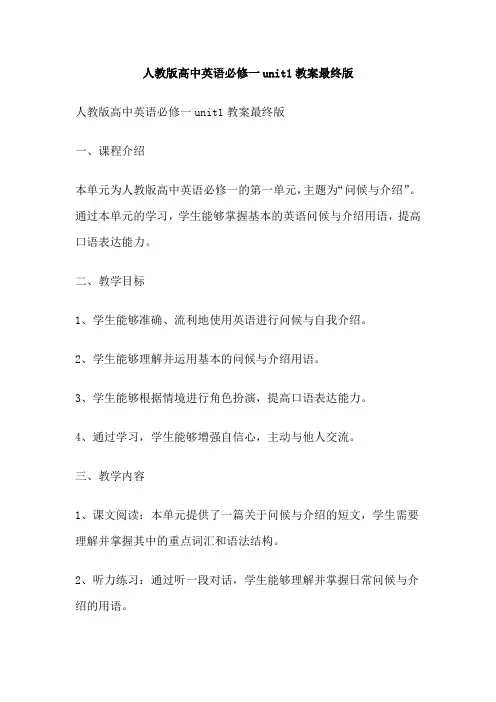
人教版高中英语必修一unit1教案最终版人教版高中英语必修一unit1教案最终版一、课程介绍本单元为人教版高中英语必修一的第一单元,主题为“问候与介绍”。
通过本单元的学习,学生能够掌握基本的英语问候与介绍用语,提高口语表达能力。
二、教学目标1、学生能够准确、流利地使用英语进行问候与自我介绍。
2、学生能够理解并运用基本的问候与介绍用语。
3、学生能够根据情境进行角色扮演,提高口语表达能力。
4、通过学习,学生能够增强自信心,主动与他人交流。
三、教学内容1、课文阅读:本单元提供了一篇关于问候与介绍的短文,学生需要理解并掌握其中的重点词汇和语法结构。
2、听力练习:通过听一段对话,学生能够理解并掌握日常问候与介绍的用语。
3、口语表达:学生需要进行多次口语练习,包括个人介绍、两人对话、小组讨论等,提高口语表达能力。
4、写作训练:学生需要写一篇关于自己或他人的介绍文章,巩固所学知识。
四、教学步骤1、导入新课:通过简单的问候,引导学生进入本单元的主题。
2、讲解新词:学习本单元的新单词,包括生词、词组和习惯用法。
3、课文阅读:阅读本单元提供的短文,并回答相关问题。
4、听力练习:听一段对话,并回答相关问题。
5、口语表达:进行多次口语练习,包括个人介绍、两人对话、小组讨论等。
6、写作训练:写一篇关于自己或他人的介绍文章。
7、复习巩固:回顾本单元所学内容,加深印象。
五、教学评价1、课堂提问:通过提问,检测学生对本单元重点内容的掌握情况。
2、小测验:进行小测验,检测学生对本单元重点词汇、语法和习惯用法的掌握情况。
3、课后作业:布置课后作业,让学生巩固本单元所学内容。
六、教学反思1、成功之处:通过多种教学方法的运用,本节课取得了良好的教学效果,学生积极参与,课堂氛围热烈。
2、不足之处:部分学生的口语表达能力还有待提高,需要加强针对性的训练。
3、改进措施:针对学生的不足,制定个性化的教学方案,加强针对性的训练,提高学生的口语表达能力。
高一英语必修一unit1教案(优秀3篇)
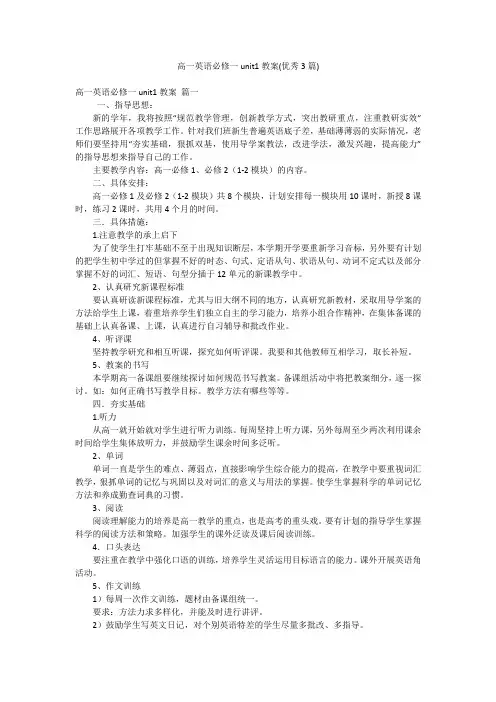
高一英语必修一unit1教案(优秀3篇)高一英语必修一unit1教案篇一一、指导思想:新的学年,我将按照“规范教学管理,创新教学方式,突出教研重点,注重教研实效”工作思路展开各项教学工作。
针对我们班新生普遍英语底子差,基础薄薄弱的实际情况,老师们要坚持用“夯实基础,狠抓双基,使用导学案教法,改进学法,激发兴趣,提高能力”的指导思想来指导自己的工作。
主要教学内容:高一必修1、必修2(1-2模块)的内容。
二、具体安排:高一必修1及必修2(1-2模块)共8个模块,计划安排每一模块用10课时,新授8课时,练习2课时,共用4个月的时间。
三.具体措施:1.注意教学的承上启下为了使学生打牢基础不至于出现知识断层,本学期开学要重新学习音标,另外要有计划的把学生初中学过的但掌握不好的时态、句式、定语从句、状语从句、动词不定式以及部分掌握不好的词汇、短语、句型分插于12单元的新课教学中。
2、认真研究新课程标准要认真研读新课程标准,尤其与旧大纲不同的地方,认真研究新教材,采取用导学案的方法给学生上课,着重培养学生们独立自主的学习能力,培养小组合作精神,在集体备课的基础上认真备课、上课,认真进行自习辅导和批改作业。
4、听评课坚持教学研究和相互听课,探究如何听评课。
我要和其他教师互相学习,取长补短。
5、教案的书写本学期高一备课组要继续探讨如何规范书写教案。
备课组活动中将把教案细分,逐一探讨。
如:如何正确书写教学目标。
教学方法有哪些等等。
四.夯实基础1.听力从高一就开始就对学生进行听力训练。
每周坚持上听力课,另外每周至少两次利用课余时间给学生集体放听力,并鼓励学生课余时间多泛听。
2、单词单词一直是学生的难点、薄弱点,直接影响学生综合能力的提高,在教学中要重视词汇教学,狠抓单词的记忆与巩固以及对词汇的意义与用法的掌握。
使学生掌握科学的单词记忆方法和养成勤查词典的习惯。
3、阅读阅读理解能力的培养是高一教学的重点,也是高考的重头戏。
最新人教版高中英语必修一+Unit+1++Friendship全单元教案(精品)名师优秀教案
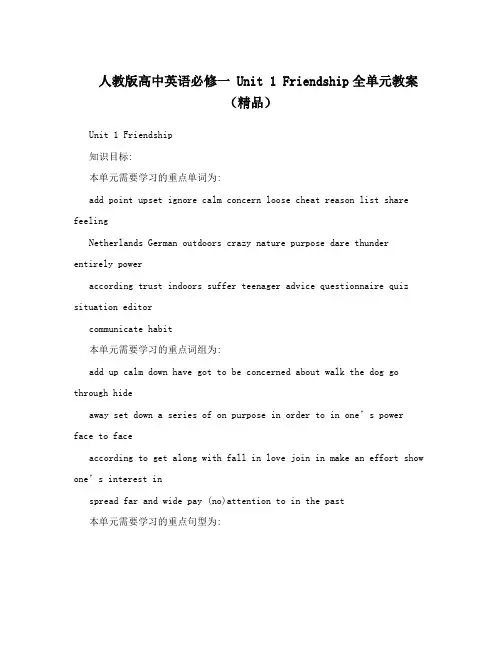
人教版高中英语必修一 Unit 1 Friendship全单元教案(精品)Unit 1 Friendship知识目标:本单元需要学习的重点单词为:add point upset ignore calm concern loose cheat reason list share feelingNetherlands German outdoors crazy nature purpose dare thunder entirely poweraccording trust indoors suffer teenager advice questionnaire quiz situation editorcommunicate habit本单元需要学习的重点词组为:add up calm down have got to be concerned about walk the dog go through hideaway set down a series of on purpose in order to in one’s power face to faceaccording to get along with fall in love join in make an effort show one’s interest inspread far and wide pay (no)attention to in the past本单元需要学习的重点句型为:1. You want to see a very interesting film with your friend, but your friend can’t go until he or she finishes cleaning the bicycle. (not. . . until. . . )2. When he or she borrowed it last time, he or she broke it and you had to pay to get itrepaired. (get sth. done)3. While walking the dog, you were careless and it got loose and was hit by a car. (while doing; get+adj. )4. Your friend, who doesn’t work hard, asks you to help him or her to cheat in the exam by looking at your paper, what will you do? (the Attributive Clause)5. I don’t want to set down a series of facts in a diary as most people do, but I want this diary itself to be my friend. (as. . . )6. I wonder if it’s because I haven’t been able to be outdoors for so long time that I’ve grownso crazy about everything to do with nature. (I wonder if/whether; it’s . . . that. . . )7. . . . I stayed awake on purpose until half past eleven one evening in order to have a goodlook at the moon for once by myself. (stay+adj. ; in order todo. . . )8. But as the moon gave far too much light, I didn’t dare open a window. (don’t dare(to)do. . . )9. . . . it was the first time in a year and a half that I’d seen the night face to face. . . (It is/was the first/second. . . time that+现在/过去完成时)10. Although I really try to talk to my classmates, I still find it hard to make good friendswith them. (find it+adj. /n. +to do. . . )本单元需要掌握的交际功能用语为:1. 态度(attitudes)Are you afraid that. . . ? I’ve grown so crazy about. . . I didn’t dare. . .2. 同意和不同意(agreement and disagreement)I agree. I think so. Exactly.I don’t agree. I don’t think so. I’m afraid not.3. 肯定程度(certainty)That’s correct. Of course not.本单元需要掌握的语法为:直接引语和间接引语(?):陈述句和疑问句1. 陈述句“I don’t want to set down a series of facts in a diary, ” said Anne.? Anne said that she didn’t want to set down a series of facts in a diary.2. 一般疑问句He asked, “Are you leaving tonight? ”? He asked us whether we were leaving that night.3. 特殊疑问句“When did you go to bed last night? ” father said to Anne.? Father asked Anne when she went to bed the night before.能力目标:1. 能运用所学语言讲述朋友间发生的事情以及朋友间的友谊和友情。
高一英语必修一第一单元教案精选5篇
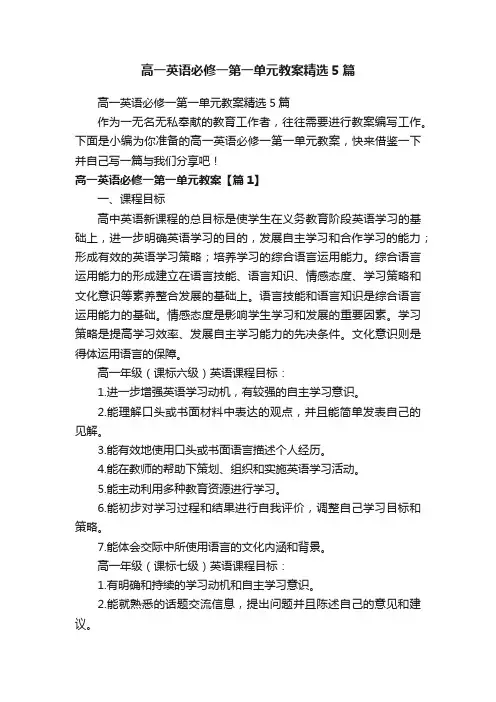
高一英语必修一第一单元教案精选5篇高一英语必修一第一单元教案精选5篇作为一无名无私奉献的教育工作者,往往需要进行教案编写工作。
下面是小编为你准备的高一英语必修一第一单元教案,快来借鉴一下并自己写一篇与我们分享吧!高一英语必修一第一单元教案【篇1】一、课程目标高中英语新课程的总目标是使学生在义务教育阶段英语学习的基础上,进一步明确英语学习的目的,发展自主学习和合作学习的能力;形成有效的英语学习策略;培养学习的综合语言运用能力。
综合语言运用能力的形成建立在语言技能、语言知识、情感态度、学习策略和文化意识等素养整合发展的基础上。
语言技能和语言知识是综合语言运用能力的基础。
情感态度是影响学生学习和发展的重要因素。
学习策略是提高学习效率、发展自主学习能力的先决条件。
文化意识则是得体运用语言的保障。
高一年级(课标六级)英语课程目标:1.进一步增强英语学习动机,有较强的自主学习意识。
2.能理解口头或书面材料中表达的观点,并且能简单发表自己的见解。
3.能有效地使用口头或书面语言描述个人经历。
4.能在教师的帮助下策划、组织和实施英语学习活动。
5.能主动利用多种教育资源进行学习。
6.能初步对学习过程和结果进行自我评价,调整自己学习目标和策略。
7.能体会交际中所使用语言的文化内涵和背景。
高一年级(课标七级)英语课程目标:1.有明确和持续的学习动机和自主学习意识。
2.能就熟悉的话题交流信息,提出问题并且陈述自己的意见和建议。
3.能读懂供高中学生阅读的英文原著简写本及英语报刊。
4.具有初步的实用写作能力,例如:事务通知和邀请信等。
5.能在教师的指导下,主动参与计划、组织和实施语言实践活动。
6.能主动扩展和利用学习资源,从多渠道获取信息,并能利用所获得的信息进行清楚和有条理的表达。
7.具有较强的自我评价和自我调控能力,基本形成适合自己的学习策略。
8.理解交际中的文化差异,初步形成跨文化交际意识。
二、课程内容完成牛津英语第三第四模块的全部内容。
有效的高一英语新人教版必修一Unit1教学方案
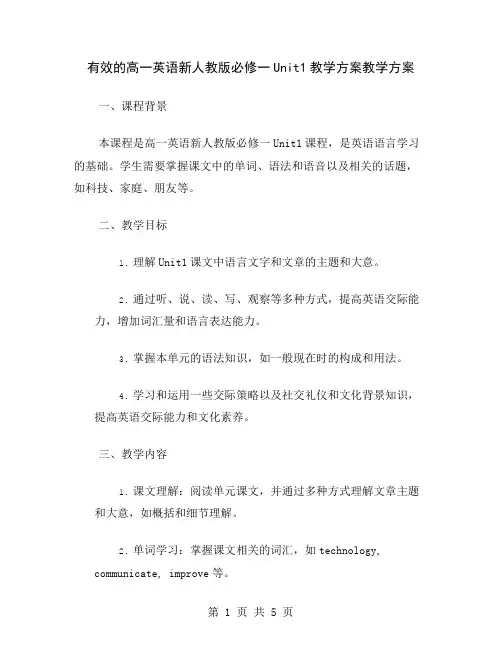
有效的高一英语新人教版必修一Unit1教学方案教学方案一、课程背景本课程是高一英语新人教版必修一Unit1课程,是英语语言学习的基础。
学生需要掌握课文中的单词、语法和语音以及相关的话题,如科技、家庭、朋友等。
二、教学目标1.理解Unit1课文中语言文字和文章的主题和大意。
2.通过听、说、读、写、观察等多种方式,提高英语交际能力,增加词汇量和语言表达能力。
3.掌握本单元的语法知识,如一般现在时的构成和用法。
4.学习和运用一些交际策略以及社交礼仪和文化背景知识,提高英语交际能力和文化素养。
三、教学内容1.课文理解:阅读单元课文,并通过多种方式理解文章主题和大意,如概括和细节理解。
2.单词学习:掌握课文相关的词汇,如technology,communicate, improve等。
3.语法知识:学习一般现在时的用法、构成和否定、疑问句的构成等。
4.口语练习:通过合作交流、角色扮演、小组讨论等方式,模拟现实生活中的交流情景,提高英语口语表达能力。
5.书写练习:在课堂上进行手写和键盘书写练习,提高英语书写水平和规范性。
四、教学方法1.任务型教学:通过任务型教学法,让学生参与课堂活动和实践,积极探究学习内容和语言形式,提高学习效果。
2.全英语教学:课堂教学语言使用英语,在潜移默化中加强学习者英语交际能力。
3.多媒体教学:利用多媒体教学手段,如影片、图片和音频等资源,激发学生学习兴趣,增加视听刺激。
4.语言实践教学:课堂教学注重实践、应用和交流,通过小组讨论、角色扮演等活动,提高学生英语语言的实际运用能力。
五、教学流程1.课前预习:师生提前预习本课内容,准备好相关教学材料。
2.课堂引导:教师对学生开展自我介绍,认识彼此,激发学生学习兴趣。
3.课文理解:利用多媒体和小组讨论等方式,让学生深入理解课文大意和相关语言形式。
4.单词学习:采用游戏、竞赛等方式,让学生更好地掌握课文中包含的单词。
5.语法知识:通过例子和练习,让学生掌握一般现在时的构成、用法和否定、疑问句的构成等语法知识。
英语优秀教案(人教新课标版):必修1(Unit1 Friendship the 6th period
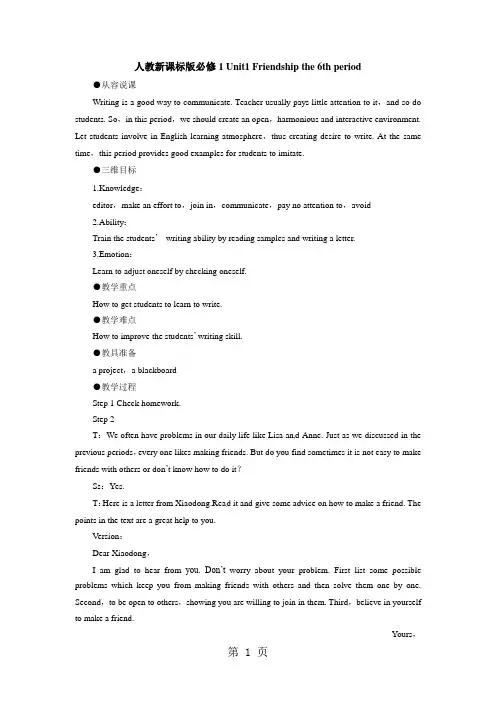
人教新课标版必修1 Unit1 Friendship the 6th period
●从容说课
Writing is a good way tocommunicate. Teacherusually pays little attention to it,and so dostudents. So,in this period,we should create an open,harmonious and interactiveenvironment. Letstudents involve in English learning atmosphere,thus creating desire towrite. Atthe same time,this period provides good examples for students to imitate.
●教学过程
Step 1 Check homework.
Step 2
T:We often have problems in our daily life like Lisa an dAnne. Justas we discussed in the previous periods,every one likes makingfriends. Butdo you find sometimes it is not easy to make friends with others or don’t know how to do it?
人教版高中英语必修一unit1优秀教案
五.教法、学法与教具 Teaching and Learning Methods and Aids
1.Teaching Methods 1. Question-inquiry Teaching 2.Task-based Learning and Teaching 3.Analytic Discussion(pair work or group work)
2.Learning Methods Skimming, Scanning, Guessing, and Discussion
3. Teaching Aids Textbook &Teacher’s Book Multimedia Devices
PPT Documents
六. 教案过程设计 Teaching Process(45mins)
Period II:Anne’s Best Friend(reading) Step I.Review and Leading-in (5mins)
人教版英语必修一unit1教案
人教版英语必修一unit1教案教案标题:Exploring Unit 1: School Life教学目标:1. 通过本单元的学习,学生将能够掌握并运用与学校生活相关的词汇和表达方式。
2. 培养学生的听、说、读、写的综合能力,提高他们的英语交际能力。
3. 培养学生的合作意识和团队精神,提高他们的学习动力和积极性。
教学重点:1. 学习并掌握与学校生活相关的词汇和表达方式。
2. 提高学生的听力和口语交际能力。
3. 培养学生的合作意识和团队精神。
教学难点:1. 学生对于新词汇和表达方式的理解和运用。
2. 学生的口语表达能力的提高。
教学准备:1. 教材:人教版英语必修一Unit 1教材及配套教辅资料。
2. 多媒体设备:投影仪、音频设备等。
3. 学生教学用具:课本、笔记本、笔等。
教学过程:Step 1: Warm-up (5分钟)通过展示一些关于学校生活的图片或视频,引发学生对于学校生活的兴趣,并进行简单的讨论,激发学生的学习动力。
Step 2: Pre-reading (10分钟)教师通过提问的方式,引导学生预测本单元课文的内容,并激发学生对于学校生活的思考。
Step 3: While-reading (30分钟)3.1 学生个人阅读课文,并回答与课文内容相关的问题,以检测学生对于课文的理解程度。
3.2 学生分组合作,进行小组讨论,分享对于学校生活的看法和体验,并准备一份小组报告,展示给全班同学。
Step 4: Post-reading (15分钟)教师组织学生进行角色扮演活动,让学生在模拟的学校生活情境中运用所学的词汇和表达方式进行交流。
Step 5: Consolidation (10分钟)教师设计一系列练习题,巩固学生对于本单元所学知识的掌握程度,并进行课堂点评和讲解。
Step 6: Homework (5分钟)布置适当的家庭作业,要求学生复习本单元所学内容,并准备下节课的学习。
教学评估:1. 在课堂上观察学生的参与度和合作情况,评估学生的学习态度和团队精神。
人教版高中英语必修一《Unit 1 Teenage life》优质课公开课课件、教案
人教版高中英语必修一《Unit 1 Teenage life》优质课公开课课件、教案【新教材】必修第一册 Unit 1 Teenage Life 教学设计Period 2 Reading and Thinking教材分析本板块包括阅读部分The freshman Challenge 和在阅读基础上完成相关的词汇和问答练习。
Reading部分介绍的是高中新生Adam在新的学习环境中面临的挑战和机会。
本文内容贴近学生生活,主人公的问题和困惑也是学生们现在所面对的,通过回答和课文有关的问题和相关的拓展问题,学生可以以积极的心态迎接自己的高中生活。
为了顺利完成Reading and Thinking 的任务,学生还要提前做好相关词汇准备。
教学目标与核心素养1. Let students master useful words and phrases related to the text;2. Let students understand the challenges Adam meets in his new school and compare the similarities and differences of their school and Adam’s;3. Help the students finish vocabulary exercises in the text book.4. Get students to understand they should learn to face difficulties and challenges in senior high school for their own future.教学重难点Importance:1. Help the students to master key words and phrases in the text.2. Guide students to compare school life in different places.3. Guide the students to learn about Adam’s school life and understand that everyone should overcome difficulties in a new situation.Difficulty:Guide the students compare their school life and Adam’s, and discuss ways to deal with challenges.课前准备1.Ask the students to prepare new words and phrases related to the contents of the text.2.Mark the new words in the textbook, understand the meaning in context, or consult the dictionary to understand the meaning.教学过程Step 1 Preparation1. freshman___________ junior high school ___________ Senior highschool___________confusing___________ choose courses___________ sign up___________extra-curricular activities___________ hand out ___________ homelesspeople___________in the community ___________ get used to doing___________ keep up with___________2. challenge _________ topic________ fluent _________ graduate ________recommend ___________ literature_________ obviously _________quit_________be responsible for _________ schedule_________ editor_________Compare school life in different placesActivity 11. Guide the students to take part in the group work and discuss school life in and outof China.Ask Ss to work in groups and discuss the questions.1) What do you want to know about the school life in other countries?Possible answers:I want to know whether they take extra courses during summer or winter vocations.I wonder if they have enough free time to develop their own interests.I am interested in what subjects they study at school.…2) What would you tell a teenager from another country about school life in China?I am happy to come to my new school and know a lot of new friends.Our teachers are patient and helpful.I feel a little worried about my study because I have more subjects to learn.…Activity 22. Read the text quickly to find the main idea of each paragraph.Guide the students to read the text quickly and fill in the blanks in this part.Paragraph1:Senior high school is a Challenge.Paragraph2:It is important to choose courses.Paragraph3:Extra-curricular activities are also important.Paragraph4:A senior high student must work harder and be more responsible.Step3 Intensive readingActivity 3Read the text again and answer the questions.Guide the students to read the text carefully and find the answers to the followingquestions.1. What causes did Adams choose? Which one do you think would be his favorite?Why?2. What does “make the team” in paragraph mean?3. What is Adam worried about?4. Is Adam confident that he will get used to senior school life? How do you know?Possible answers:1. Adam chooses Math, English chemistry, world history and Chinese. I think.English advanced literature is his favorite because he likes English, and he is good at it.2. It means joining the football team.3. He is worried that he can’t keep up with other students in his advanced course andget used to all the homework.4. Yes, he is. On the one hand, Adam knows that he has to study harder as a seniorschool student to be well prepared for his future. On the other hand, Adam knowsthat school advisers and teacher can give him help when he is faced with problems.Activity 4Complete the outline. Then discuss the questions below with a partner.Get the students to work in pairs and fill in the blanks after discussing the questions carefully. Encourage the students to find clues from the text.Paragraph Challenge HowAdamfeelsSolution1Becoming a freshman atsenior high schoolConfused2Choosing suitable courses Hopeful The schooladvisor helpshim choosesuitablecourses.3Joining the schoolfootball team Unhappy He will finda way toimprove onhis own.4Keeping up with the otherstudents in his advancedcourses Worried Hewill studyharder andbe moreresponsible.Guide the students to discuss the following questions and encourage them to answer the questions according to Adam’s story and their own situation.1. What kind of person do you think Adam is? Why?3. What are some differences between Adam’s school and your school life?Possible answers:1. Adam is clear-minded and responsible for himself. When he chooses courses, he knowshis advantages。
最新人教版高中英语必修一Unit+1+Friendship教材分析名师优秀教案
最新人教版高中英语必修一U n i t+1+F r i e n d s h i p 教材分析名师优秀教案人教版高中英语必修一Unit 1 Friendship教材分析摘要:随着外语教学的发展和外语教材的开放和繁荣,越来越多的外语教材涌入市场,可供学生和教师选择的外语教材越来越丰富。
教材选择上的失误,不仅会造成经济上的浪费,而且会给学生的学习时间和精力造成不可挽回的损失。
本文主要从教材评价的有系统评价的内部评价和外部评价对人教版高中英语必修一unit1 Friendship进行了分析,并提出教学建议。
关键词:教材分析;语言知识;语言技能一、引言人教版高中英语必修一Unit 1 Friendship 是以friendship 为话题。
并且是高一学年的第一学期的开始。
以friendship 为话题为高中英语学习生涯的开篇。
通过设置问题开发学生的思维,并通过阅读材料让学生了解friendship,借助听力,讨论阅读,写作等一系列的扎实有效的教学活动,进一步发挥学生的想象力,提高学生的语言实践能力,并通过掌握相关词汇,为阅读和写作创造条件。
二、理论依据1.教材评价的意义:教材评价的意义是显而易见的。
第一,教材评价有利于教育行政部门、学校以及教师为某一英语课程或某一学生群体选择教材时作出正确的决策。
第二,教材评价有利于教师在实际教学中对教材进行取舍或调整。
第三,教材评价有利于教育行政部门、学校以及教师对已经选用的教材进行再评价。
第四,教材评价有利于教材编写者吸收现有教材的优点,从而开发更好的教材。
第五,教材评价有利于教材开发者正确认识自己编写的教材。
2.教材评价的原则:教材评价有两个主要原则:效果原则和效率原则。
教材评价的效果原则就是指考察教材是否能够达到预先设想的效果。
教材评价的效率原则是指被评价的教材是否比其他教材能够更加有效地满足学习需要,达到预先设想的学习效果。
3.教材评价的方法:教材评价方法可以分为随意的印象性评价和有系统的评价两大类。
- 1、下载文档前请自行甄别文档内容的完整性,平台不提供额外的编辑、内容补充、找答案等附加服务。
- 2、"仅部分预览"的文档,不可在线预览部分如存在完整性等问题,可反馈申请退款(可完整预览的文档不适用该条件!)。
- 3、如文档侵犯您的权益,请联系客服反馈,我们会尽快为您处理(人工客服工作时间:9:00-18:30)。
教师学科教案[20 - 20学年度第—学期]任教学科:________________ 任教年级:________________ 任教老师:________________xx市实验学校U nit one FriendshipTeaching aims:1. 能力目标:a. Listening: get information and views from the listening material;b. Speaking: express one 's attitude or views about friends and friendship inappropriate words.c. Reading: enable the Ss to get the main idead. Writing: write some advice about making friend as an editor2. 知识目标:a. Talk about friends and friendship; how to make friends; how to maintainfriendshipb. Use the following expressions:I think so. / I don 't think so.I agree. / I don 't agree.That 's correct.Of course not.Exactly.I 'm afraid not.c. to enable the Ss to control direct speech and indirect speechd. vocabulary: upset , calm , concern , loose, Netherlands, German, series, outdoors, dusk, crazy , purpose , thunder , entire, entirely, power , curtain, dusty, partner, settle, suffer , highway, recover, pack, suitcase, overcoat, teenager, exactly, disagree, grateful, dislike, tip , swap , itemadd up \ calm down\ have got to \be concerned about \ walk the dog \ go through \ set down \a series of \ on purpose \ in order to \ at dusk \ face to face \ no Ion ger\ not …any longSer from' get\be tired of \ pack sth. up \get along with \ fall in love \ join in3. 情感目标:a. To arose Ss 'interest in learning English;b. To encourage Ss to be active in the activities and make Ss to be confident;c. To develop the ability to cooperate with others.4. 策略目标:a. To develop Ss 'cognitive strategy: taking notes while listening;b. To develop Ss 'communicative strategies.5. 文化目标:to enable the Ss to get to know different opinions about making friends from different countries.Teaching steps:Period oneStep1. Warming up1. Ss liste n to an En glish son gAULD LANG SYNE.2. Brain storm ing: let Ss say some words aboifrie ndship - hon est, frie ndly, brave,humorous, funny, wise, kind, ope n-min ded, resp on sible, helpful - Step 2. Talk about your old friends1. Ss talk about their old friends in Junior Middle School, talk about theirappeara nee, pers on ality, hobbies, etc.2. Self-introductionStep 3. Make new frie nds1. Ss go around and ask their new friends some information and fill in the following form2. Report to the class: who will probably be your friend. Why?Step 4. Do a surveySs do the survey in the text ,P1Sep 5. Liste ning and talk ingDo Wb P41 (Talk in g). While Ss liste n to the material, ask them to take n otes about the speaker 's views of making friends.When Ss make their conv ersati on, ask them to try to use the followi ng expressi ons.I think so. / I don ' t think so. I agree. / I don ' t agree.That's correct. Of course not. Exactly. I 'm afraid not.Step 6. Discussi onDivide Ss four in one group and each group choose a topic to discuss. There are four topics.Topic 1: Why do you n eed frie nds? Make a list of reas ons why frie nds are importa nt to you.Topic 2: There is a say ing “ to have a good frie nd, you n eed to be a good frie nd.do you thi nk of the say ing and how can you be a good friend?Topic 3: Does a frie nd always have to be a pers on? What else can be your frie nd? Why?Topic 4: List some qualities of a pers on who does not make friend easily.Step 7. Summary1. Ask Ss themselves to summarize what is friendship and what is the most important in maki ng frien ds.2. T shows more information about friendship and a poem about friendship.What is frien dship?I want to find the answer to the questionWhat is frien dship?Whe n it rain s, I think frie ndship is a small umbrella.It can give me a piece of clear sky.When I 'm crying, I think friendship is a white handkerchief.It can wipe my tears dry.When I am sad, I th ink frie ndship is a warm word.It can bring me happ in ess aga in.Whe n I am in trouble, I thi nk frie ndship is a strong hand.It can help me escape my troubles.When I sit in a quiet place, I think friendship is a very wonderful feeling.It can ' t be pulled and torn, because it is in every one 's heart.It is there from the beg inning to the end of our lives.3. Tell Ss: make new frie nds and keep the old; one is silver and the other is gold. Step 8. Evaluati onSs fin ish the followi ng evaluati on form. Sta ndard: A, B,CHomework:1. Look up the new words and expressions in warming up and pre-reading in a dictio nary.2. Write a short passage about your best friend.Period twoStep1.Warm ing upActivity1: Suppose you have to stay in doors to hide yourself for a whole year. You can n ever go outdoors, otherwise you will be killed. You have no teleph one, computer, or TV at home.How would you feel?What would you do?Four stude nts a group discuss with each other for 2 minu tes.Activity2: Play a short part of the movies Schindler ' s ListStep2. Predicti ngStudents read the title of the passage and observe the pictures and the outline of it toguess:Who is Anne 's best friend?What will happe n in the passage?Step3. Skimmi ngStude nts skim the passage in 2 minu tes to get the main idea : Who is Anne 's best friend?When did the story happe n?Step4. Sca nningStudents work in pairs to find the information required below:AnneStep5. Inten sive read ingStudents work in group of four to discuss the following open questions:1. Why did the wi ndows stay closed?2. How did Anne feel?3. What do you think of Anne?4. Guess the meanings of “ spellbound ” , “ hold me entirely in their power ” fromdiscourse语篇,上下文).5. Which senten ces attract you in the passage?Step6. ActivityFour stude nts a group to discuss the situatio n:Suppose you four have to hide yourselves for 3 mon ths. During the three mon ths, you will be offered the basic food, water and clothes. Your group can take 5 things with you.What will you take? Why?How will you spe nd the 3 mon ths?How will you treat each other and make friends ?Step7.Assig nmentTaskl .Surf the internet to find Anne' s Diarya nd read some of it. Print out a piece of the diary and write down your feelings after reading it on the page. We will share the piecesand your feelings with the whole class.Task2.Ex2、3、4on Page3Period threeStep 1. Warming upCheck the Ss 'assignment: task 2Step 2. Language points:1. add (v.)1). To put together with something else so as to increase the number, size, importa nee, etc 增加,添力卩Please add something to what I 've said, John.2). To join nu mbers, amount, etc so as to find the tota 相力卩Add up these figures for me, please.add to something: to increase 增加What he did has added to out difficulties.add up to: to amount to 加起来等于;总计The cost added up to 100 million yuan.2. go through1) . To examine carefully 仔细阅读或研究I went through the students 'papers last night.2) . To experience 经历,遭受或忍受You really don 't know what we went through while working on this project.3. crazy (adj.)1) . mad, foolish 疯狂的,愚蠢的It 's crazy to go out in such hot weather.2) . wildly excited; very interested 狂热的,着迷的She is crazy about dancing.4. be concerned about/for: be worried about担心We're all concerned about her safety.Step 3. Learning about language1. Finish Ex.1, 2 and 3. on Page 4.2. Direct speech and indirect speech: Ss do Ex.1 and 2 on Page 5. Then let the Ss themselvesdiscover the structures.Step 4. PracticeUsing structures on Page 42: ask the Ss to use indirect speech to retell the story. Step 5. AssignmentFinish Wb. Ex, 1 and2 on page 41 and 42.Period fourStep 1. RevisionCheck the Ss 'assignment.Step 2. ReadingSs read the letter on page 6Notes:1. get along with2. fall in loveStep 3. ListeningSs should take notes while they are listening.1. first listening: Ss listen and answer the questions of part 2 on page 6.2. second listening: Ss listen again and finish part 3 on page 6.Step 4. ListeningSs listen to a story about Anne and try to finish Wb. Ex 1 and 2 on page 43 and page 44. Step 5. SpeakingSs work in groups of four. Design a questionnaire to find out what kind of friends your classmates are. They can use the quiz in the Warming up to help them. Step 6. Assignment1. Ss prepare the reading task on page 44.2. Surf the internet and find some material about friendship in different countries.Period fiveStep 1. Warming upSs say something about making friends and how to maintain friendship.Step 2. ListeningSs listen to a short passage and fill in the blanks on page 41 (listening).Step 3. Reading1. first reading: Ss read the passage about friendship in Hawaii and finish Wb.Ex1.on page44.2. second reading: Ss read again and discuss the questions on page 44.3. Ss share their material about friendship in different countries in groups, and then choosesome groups to show theirs in class.Step 4. assignmentSs collect some proverbs about friendship.Period sixStep 1. Pre-writing1. Read a letter from a student called Xiaodong.2. Go over the advice on page 7 and be ready for writing.Step 2. While-writingAsk the Ss to write a letter to Xiaodong as an editor and give him some advice.1. Ss make a list about the important information that they need.2. Ss begin to write the letter to Xiaodong.3. Ss revise their letters by themselves.4. Ss exchange their writing paper with their partners and correct the mistakes.(te nse, spelli ng, letters, structures ….)5. Ss get back their own writing paper and write the letter again.Step 3. Post-writingChoose some students 'writing paper and show in the class. Ask the Ss to correct the mistakes together and also learn from some good writings.Step 4. Writing for fun1. Ss read the passage on page 7 by themselves.2. Ss try to write a few lines to describe their best friends or a person they know.3. Show some Ss'writings in class.Step 5.AssignmentDo Wb writing task on page 46.Period sevenTeachers can use this period freely.Suggestion: Teachers can use this period to let Ss sum up what they have learned and explain what Ss couldn 't understand very well in this unit. Teachers can also add more practice in this period to consolidate what the Ss have learned. Finally, ask the Ss to finish checking yourself on page 47. It is very important to improve their learning.。
